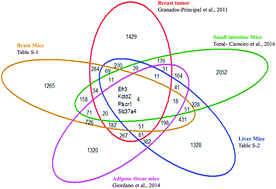Hydroxytyrosol (HT) is involved in healthful activities and is beneficial to lipid metabolism. Many investigations focused on finding tissue-specific targets of HT through the use of different omics approaches such as transcriptomics and proteomics. However, it is not clear which (if any) of the potential molecular targets of HT reported in different studies are concurrently affected in various tissues. Following the bioinformatic analyses of publicly available data from a selection of in vivo studies involving HT-supplementation, we selected differentially expressed lipid metabolism-related genes and proteins common to more than one study, for validation in rodent liver samples from the entire selection. Four miRNAs (miR-802-5p, miR-423-3p, miR-30a-5p, and miR-146b-5p) responded to HT supplementation. Of note, miR-802-5p was commonly regulated in the liver and intestine. Our premise was that, in an organ crucial for lipid metabolism such as the liver, consistent modulation should be found for a specific target of HT even if different doses and duration of HT supplementation were used in vivo. Even though our results show inconsistency regarding differentially expressed lipid metabolism-related genes and proteins across studies, we found Fgf21 and Rora as potential novel targets of HT. Omics approaches should be fine-tuned to better exploit the available databases.

